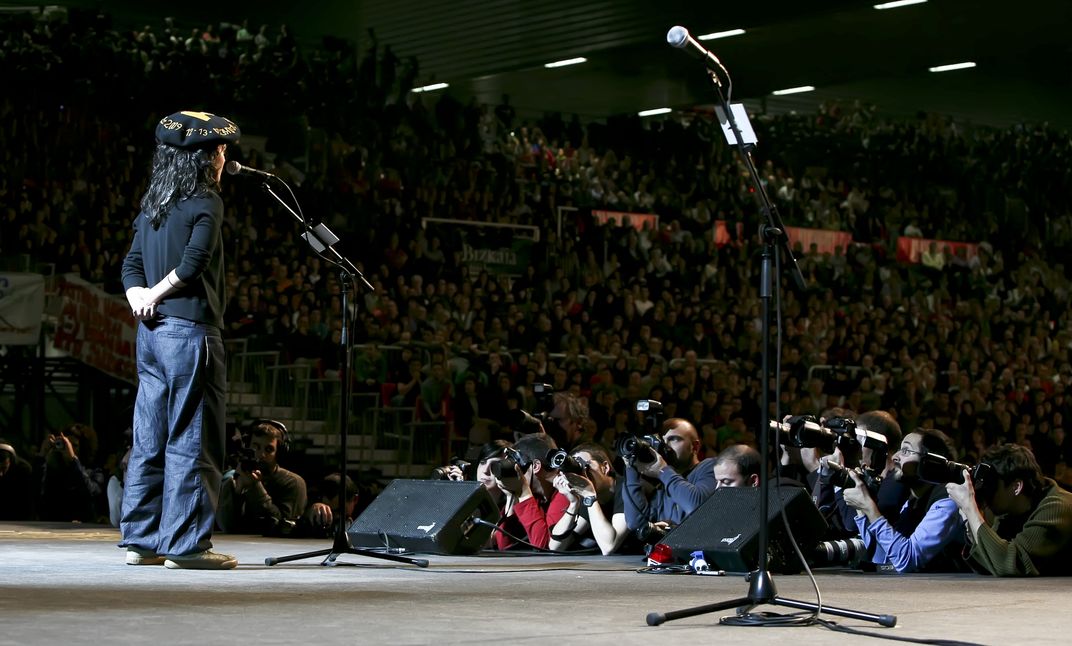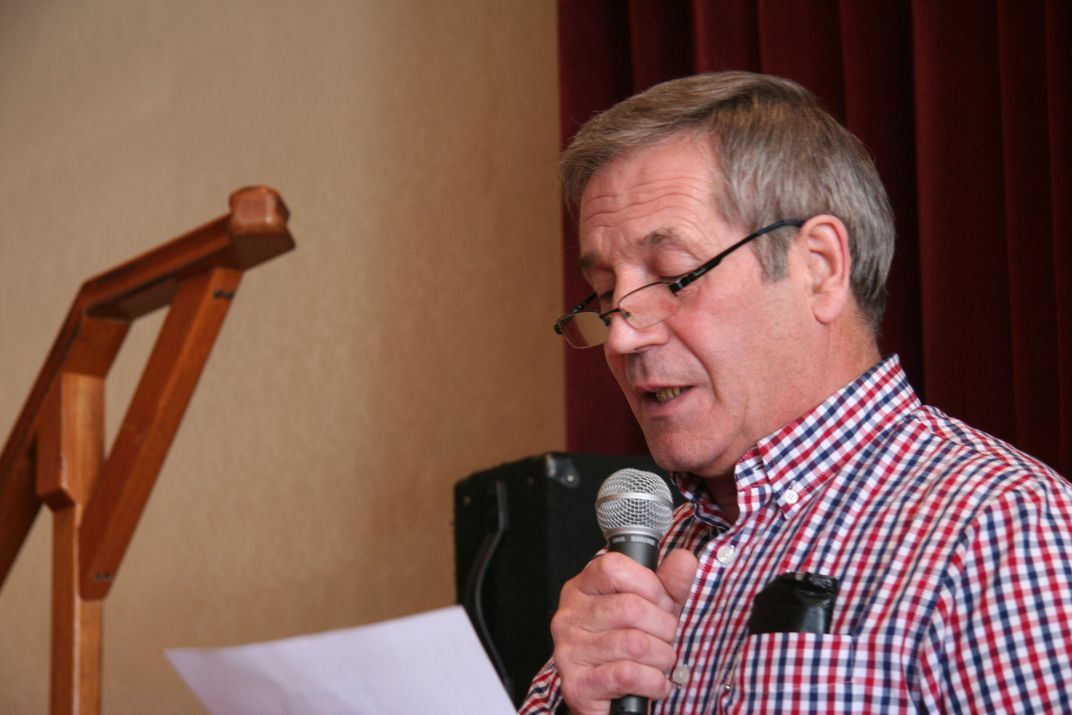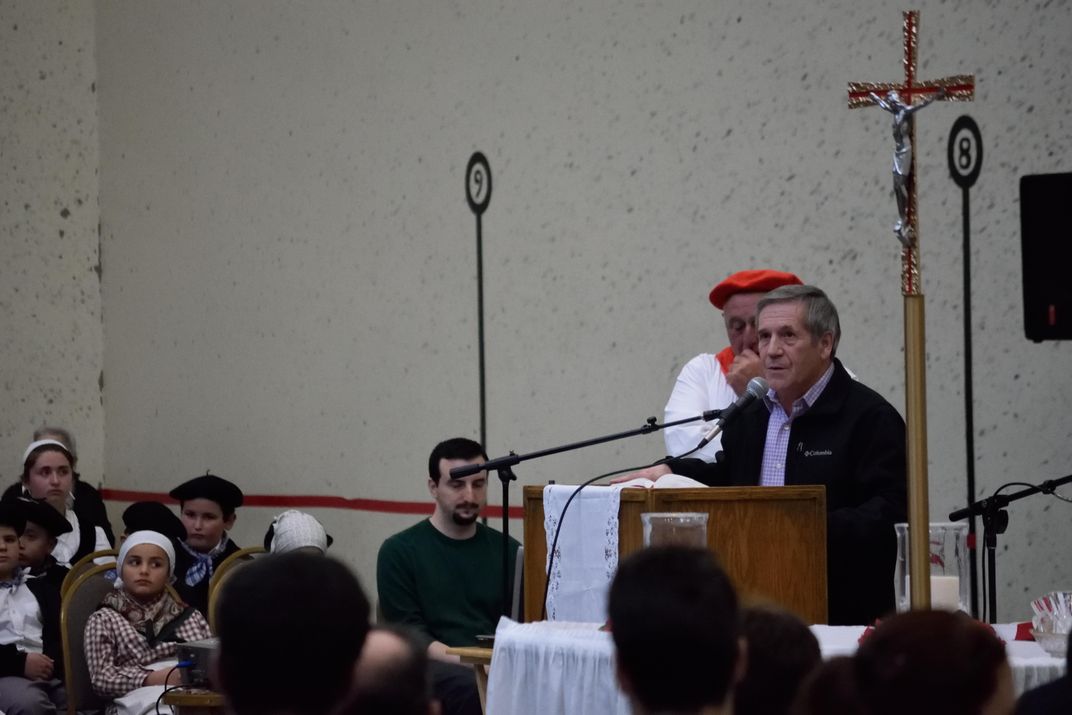What Is Bertsolaritza and Who Are the Basque Poets Who Know It?
At the Folklife Festival, be sure to catch the singing, improvisational poetry slam that’s keeping a language alive
Part poetry-slam, part hip-hop freestyling, part a cappella singing and 100 percent improvisational, the tradition of bertsolaritza has become a cultural signifier for the Basque diaspora.
Thousands of bertsolaris (singer-poets) around the globe perform bertsolaritza (improvised verse in song) at weddings, festivals and funerals—wherever there are Basque gatherings, from the Basque Country to Argentina to America. Every four years, the top bertsolaris gather for the Super Bowl of bertsolaritza at a stadium in the Basque Country, where tens of thousands adoring fans eagerly await the singers’ creations.
Americans will have a chance to witness bertsolaritza firsthand at the Smithsonian Folklife Festival, being held over two weekends from June 29 to July 4 and July 7 to July 10. The language, the cooking, the sport, the music and the crafts of this ancient community is featured in the Festival's "Basque: Innovation by Culture" program.
To do well, a bertsolari must know the Basque language, Euskara, backwards and forwards. He or she must be clever, quick-witted and have a good voice. In the head-to-head competitions, each bertsolari is given a character, a topic or a scenario, and a melody. Each spins a story, in rhyming verse, which must be completed in under two minutes. The two bertsolaris play off each other, attempting to one-up the previous singer with the better rhyme, melody or story. It’s a verbal duel that may devolve into teasing and innuendo.
“You have to manage melody, you have to manage rhyme, you have to manage different kinds of poetic structures, you have to be responding to the topic, you have to respond to the person who went before you, and so you have all those things you have to do, all at once,” said the late scholar of oral tradition John Miles Foley in a video (above).

“You’re also reacting to the audience and how the audience is reacting to you,” says Mary Linn, curator of cultural and linguistic revitalization at the Smithsonian Institution’s Center for Folklife and Cultural Heritage. The crowd may laugh or sing along. “It feeds into the energy of the bertsolari,” says Linn.
The audience will frown if the bertsolari uses the same rhymes more than once. That’s not only a faux pas, but it’s considered “junior varsity,” says John Ysursa, an instructor in Basque studies at Boise State University.
At the Folklife Festival, two of the top singers from Basque Country—Xabier Paya and Arati Anda Villanuvea—will be showing off their rhyming chops. Paya is the author of An Anthology of Basque Oral Literature, and won the grand prize at the provincial Txapeleketa Bertsolari Biscay (Biscay Bertsolari Championship) in 2006. A champion mountain climber, Anda Villanuvea also competes regularly in another provincial bertsolari championship in Alava.
Two American expatriate Basques—Martin Goicoechea and Franxoa Biduarreta—will be translating the verse into English and interpreting their meaning. “We wanted people to not be afraid to go to a poetry event in another language,” says Linn. The verses created at the festival will be preserved and put up on the Folklife Festival’s blog.
Historically, the Basque have resided in northwestern Spain and southeastern France, hugging the Atlantic coast and stretching along and across the Pyrenees Mountains. The autonomous Basque Country (Euskal Herria in Basque)—which has a president and a parliament—was established in 1979. The 2,800-square-mile nation, with a population of two million, comprises the Spanish provinces of Álava, Guipúzcoa, and Vizcaya. Many Basque also live in Navarre, and some 250,000 reside in a cultural region in France, the Pays Basque.
The language—Euskara—is thought to be one of the oldest in Europe. Its origins are uncertain; some speculate that it comes from the Caucasus, but no one has been able to definitively trace its beginnings. Euskara was on the verge of dying out at the end of the 19th century because of migration, assimilation and other factors, says Ysursa.
Its demise was almost sealed thanks to the Spanish Civil War, when the Basque allied with the Republicans against General Francisco Franco. When Franco prevailed, the new dictator returned the favor by suppressing the Basque people, language and culture—which helped fan the flames of a separatist movement that has continued well beyond Franco’s death in 1975.
Twentieth-century modernization also winnowed down the number of Basque speakers and interest in the language, Linn says.
The great folklorist Alan Lomax went to the Basque region in the early 1950s to document and preserve the songs and oral traditions, including bertsolaritza. The collection is housed in the Library of Congress’ American Folklife Center.
Bertsolaritza is uniquely Basque; barring translations, the verses are never sung in Spanish, French or any other language, says Linn. The art form began—some time in the 14th century, scholars think—as an almost entirely female pursuit. At some point, it crossed the gender line, and became a kind of barroom boast performed mostly by men in the well-loved cider houses. If you were good enough, “you could get people to keep buying you drinks,” says Ysursa.

Throughout the 18th and 19th centuries the songs were also performed at festivals, family gatherings, weddings and funerals. Some bertsolari wanted to elevate the art, so began holding contests during the late 19th century. The first modern bertzolaritza championships were held in San Sebastian in 1935 and 1936, but another was not held until 1960. The championships occurred irregularly until 1986, when something akin to a sports league was formed, the Bertsolaris Association of Euskal Herria. It has crowned its league champion every four years.
The singing verse has become “a symbol of Basque renaissance—of reclaiming the life, of reclaiming the culture,” says Linn.
Euskara is still threatened—with just under one million speakers, it is considered endangered. That’s even as the number of speakers has been growing thanks to efforts in the Basque Country—such as requiring Spanish speakers to take Basque classes, says Ysursa. And bertsolaritza classes are offered at elementary schools throughout the Basque Country.
The tradition has been kept alive in the U.S. by several bertsolaris, but it is not as likely to survive here, says Ysursa. The number of Euskara speakers in the U.S. is dwindling. “And then, compounding it, not just anyone can do this,” he says.
Ysursa, the son of Basque parents, is himself trying to learn the language. Boise is a hotbed of Basque people and culture, and even has a Basque immersion preschool. Other Basque are concentrated in the American West, where they were first brought in to help at sheep ranches: in Nevada around Reno and Elko; in the California towns of Bakersfield, Fresno, Encino and San Francisco; and in Wyoming.
One of the more accomplished expatriate bertsolaris is Martin Goicoechea, 68, of Rock Springs, Wyoming, who was awarded a National Heritage Fellowship in 2003 by the National Endowment for the Arts.

Linn says Goicoechea’s singing is unique, much different than that heard in the homeland. “He uses quarter tones,” a type of singing that is more associated with music from the Middle East, she says.
It is probably no small irony that Goicoechea owns what is billed as “Wyoming’s Largest Pre-Owned Automotive Dealership.” As a bertsolari, he aims to sell the audience on his character and his story. And of course, he has to be quick on his feet and always calculating.
Goicoechea came to America in 1966. The then-18-year-old joined an older brother at a sheep ranch, and quickly moved up to foreman, managing almost two dozen workers in the busy summer season. Within a decade, he’d met an American girl, married her and moved to Rock Springs, where he started his auto business.
He’d left the Basque Country behind, along with his early love of bertsolaritza—something he’d been so good at that he came close to winning a contest at age 17. For more than two decades he did not sing. Then he heard about a bertsolaritza competition being held in Gardnerville, Nevada. That was in 1991. Goicoechea decided to just show up, and, he says, “I’ll be honest with you, I did a lot better than I expected myself.”
It was there that he met Johnny Curutchet, Jesus Arriada, and Jesus Goni—all bertsolaris who were living in the west and who eventually collected National Heritage Fellowships along with Goicoechea in 2003.
To do well, “you’ve got to be born with talent,” Goicoechea says. If he’s just going to be singing casually, say after a family meal, he’ll listen to the dinnertime conversations, makes mental notes about the jokes, the serious topics, the dramas. “I really stay on top of what’s going on,” he says. Then, he’ll settle on the last rhyme and the last lyric for his verse.
“That is something we already know—how we’re going to finish it, even if we don’t know how to start,” says Goicoechea. “It’s like walking backwards.”
The audience may not know where the song is going until the very end, when the bertsolari delivers the final kick, he says.
Like Goicoechea, Curutchet, 70, followed an older brother to America, landing in San Francisco. But, in a twist, he’d been born in that city. (His parents were emigres to the Bay Area, but moved back to the Basque Country just after he was born.) As a teenager, Curutchet needed work, so he went back to America. He had been fiercely drawn to bertsolaritza contests at festivals near his village in the Basque Country, but did not learn the art until he returned to the U.S.
Contests in America have been few and far between, and it’s not easy to find singing partners, says Curutchet. He and Goicoechea describe each other as lifelines. “Martin is like a brother to me,” Curutchet says.
The two have performed together in the west, in Washington, in New York, and, last fall, in the Basque Country, where they “were treated like kings,” says Curutchet. They have not competed against each other often, but it is usually entertaining, they say. One memorable competition pitted Curutchet as Hillary Clinton against Goicoechea as Monica Lewinsky. To Curutchet, staying in character is a crucial aspect of the storytelling. Even if it is a laughing matter, the bertsolari should not be laughing, he says.
Like Goicoechea, Curutchet has an American family, none of whom speak Basque. Curutchet says he knows of no other American bertsolaritzas coming up behind him and his few peers. “I wish there were some new ones coming,” he says.
None of the U.S.-based Basque studies programs or Basque Cultural Centers offer bertsolaritza instruction. Goicoechea is hopeful that, at least in other Basque areas that, “as the language expands, the art will follow.”
But, both he and Curutchet say it’s unlikely there will be more American bertsolaris.
“They’re going to miss us when we’re gone,” says Goicoechea.
Workshops and demonstrations on bertsolitza will be taking place throughout the Folklife Festival on the National Mall from June 29 to July 4 and from July 7 to July 9.
/https://tf-cmsv2-smithsonianmag-media.s3.amazonaws.com/accounts/headshot/AliciaAult_1.png)


/https://tf-cmsv2-smithsonianmag-media.s3.amazonaws.com/accounts/headshot/AliciaAult_1.png)